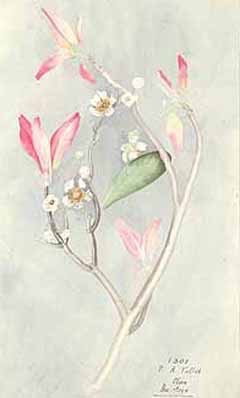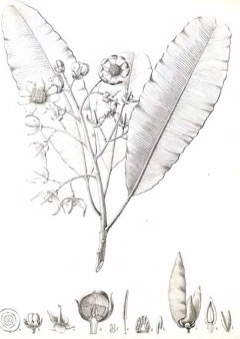 |
|
http://www.edibleplants.org |
 |
| http://www.edibleplants.org |
Translate this page:
Summary
Found in Western tropical Africa, Niam Tree or Lophira alata is an extremely large tree growing usually about 40-60 m tall. It has a long, narrow crown and long, straight trunk that can be unbranched for up to 30 m and up to 180 cm in diameter. It has large buttresses at the base. It is one of the most over exploited species due to its strong, heavy, and highly durable timber. It also yields high quality edible oil. The oil is used as a hair oil and for soap-making.
Physical Characteristics

 Lophira alata is an evergreen Tree growing to 40 m (131ft) by 30 m (98ft) at a slow rate.
Lophira alata is an evergreen Tree growing to 40 m (131ft) by 30 m (98ft) at a slow rate.
See above for USDA hardiness. It is hardy to UK zone 10.
Suitable for: light (sandy), medium (loamy) and heavy (clay) soils, prefers well-drained soil and can grow in nutritionally poor soil. Suitable pH: mildly acid and neutral soils and can grow in very acid soils.
It cannot grow in the shade. It prefers moist soil.
UK Hardiness Map
US Hardiness Map
Synonyms
Lophira africana Banks ex G.Don Lophira barteri Tiegh. Lophira macrophylla Tiegh. Lophira procera A.
Plant Habitats
Edible Uses
Edible Parts: Fruit Oil
Edible Uses: Oil
The fruits can be used to make an edible oil[402 ].
References More on Edible Uses
Medicinal Uses
Plants For A Future can not take any responsibility for any adverse effects from the use of plants. Always seek advice from a professional before using a plant medicinally.
None known
References More on Medicinal Uses
The Bookshop: Edible Plant Books
Our Latest books on Perennial Plants For Food Forests and Permaculture Gardens in paperback or digital formats.

Edible Tropical Plants
Food Forest Plants for Hotter Conditions: 250+ Plants For Tropical Food Forests & Permaculture Gardens.
More

Edible Temperate Plants
Plants for Your Food Forest: 500 Plants for Temperate Food Forests & Permaculture Gardens.
More

More Books
PFAF have eight books available in paperback and digital formats. Browse the shop for more information.
Shop Now
Other Uses
Essential Hair Oil Soap Wood
Agroforestry Uses: The plant is a pioneer species and is representative of a disturbed forest[402 ]. Other Uses An oil obtained from the seed is used as a hair oil and is also suitable for making soap[46 ]. The heartwood is dark red, chocolate brown, or purple brown with conspicuous white deposits in the vessels; it is clearly demarcated from the 2 - 5cm wide band of pale pink sapwood; there is an intermediate zone between the heartwood and sapwood. The texture is coarse; the grain usually interlocked; lustre low; there is no characteristic odour or taste. The wood is very dense; very hard; very heavy; elastic; very durable, being resistant to fungi, dry wood borers, termites and toredo. It seasons slowly, with a high risk of checking and distortion; once dry it is poorly stable in service. It is very difficult to work with hand and machine tools; there is a severe blunting effect if machined when dry so stellite-tipped and tungsten carbide tools are recommended; it can be dressed to a smooth finish, though there can be difficulties due to the interlocked grain; nailing and screwing are good, but require pre-boring; the gluing properties are usually good for interior purposes, but care must be taken because of the dense wood. It is resistant to acids and has good weathering properties. It is used for heavy, durable construction work, harbour work such as jetties, heavy-duty flooring, parquet flooring, railroad crossties[316 , 338 , 848 ]. Because the wood is rich in silica, and is resistant to marine borers, it isd favoured for use in jetties[338 ].
Special Uses
References More on Other Uses
Cultivation details
Grows best in a sunny position[299 ].Plants are sensitive to drought[402 ]. It is estimated that is takes 220 years for a tree to reach a girth of 2.7 metres in Nigeria[402 ]. Light gaps in the forest are necessary for successful regeneration, as seed germination does not occur in shady understorey[402 ].
References Carbon Farming Information and Carbon Sequestration Information
Temperature Converter
Type a value in the Celsius field to convert the value to Fahrenheit:
Fahrenheit:
The PFAF Bookshop
Plants For A Future have a number of books available in paperback and digital form. Book titles include Edible Plants, Edible Perennials, Edible Trees,Edible Shrubs, Woodland Gardening, and Temperate Food Forest Plants. Our new book is Food Forest Plants For Hotter Conditions (Tropical and Sub-Tropical).
Shop Now
Plant Propagation
Seed - best sown as soon as it is ripe since the seed has a short viability[299 ]. Even sown fresh, germination rates are usually less than 50%, dropping to 5% after 3 months[299 ]. Germination takes 3 - 5 weeks[299 ]. To improve growth in the nursery, it is recommended to add soil from under an established tree to the substrate to ensure development of mycorrhizal fungi[299 ]. Air layering is possible. A rooting percentage of marcots of more than 60% has been obtained with cow dung as substrate and IBA (0.8%) as growth hormone[299 ]. Stem cuttings are also possible[299 ].
Other Names
If available other names are mentioned here
Niam Tree, Akoga, Akufo, Azobe, Bongossi, Bonkole, Ega, Ekki, False Shea, Hos, Kaku, Kofyo, Lekwa, Ngokele, Okoa, Okoka,
Native Plant Search
Search over 900 plants ideal for food forests and permaculture gardens. Filter to search native plants to your area. The plants selected are the plants in our book 'Plants For Your Food Forest: 500 Plants for Temperate Food Forests and Permaculture Gardens, as well as plants chosen for our forthcoming related books for Tropical/Hot Wet Climates and Mediterranean/Hot Dry Climates. Native Plant Search
Found In
Countries where the plant has been found are listed here if the information is available
Cameroon; Congo; Congo, The Democratic Republic of the; Côte d'Ivoire; Equatorial Guinea; Gabon; Ghana; Liberia; Nigeria; Sierra Leone, Africa, Benin, Cameroon, Central Africa, CAR, Central African Republic, Congo, Côte d'Ivoire, East Africa, Equatorial-Guinea, Gabon, Ghana, Guinea, Guinée, Ivory Coast, Sierra Leone, Sudan, Togo, Uganda, West Africa,
Weed Potential
Right plant wrong place. We are currently updating this section.
Please note that a plant may be invasive in one area but may not in your area so it’s worth checking.
Conservation Status
IUCN Red List of Threatened Plants Status : Status: Vulnerable A1cd

Growth: S = slow M = medium F = fast. Soil: L = light (sandy) M = medium H = heavy (clay). pH: A = acid N = neutral B = basic (alkaline). Shade: F = full shade S = semi-shade N = no shade. Moisture: D = dry M = Moist We = wet Wa = water.

Expert comment
Author
Banks ex C.F.Gaertn.
Botanical References
Links / References
For a list of references used on this page please go here
A special thanks to Ken Fern for some of the information used on this page.
Readers comment
| Add a comment |
|
If you have important information about this plant that may help other users please add a comment or link below. Only comments or links that are felt to be directly relevant to a plant will be included. If you think a comment/link or information contained on this page is inaccurate or misleading we would welcome your feedback at [email protected]. If you have questions about a plant please use the Forum on this website as we do not have the resources to answer questions ourselves.
* Please note: the comments by website users are not necessarily those held by PFAF and may give misleading or inaccurate information.
To leave a comment please Register or login here All comments need to be approved so will not appear immediately.
|
|